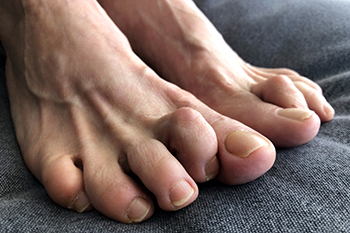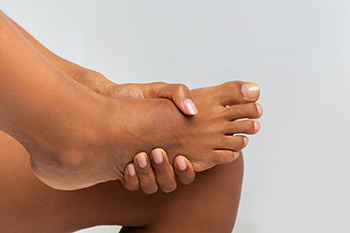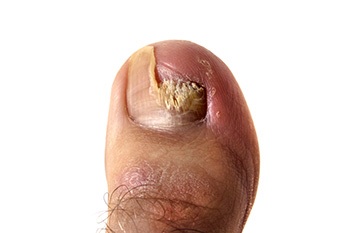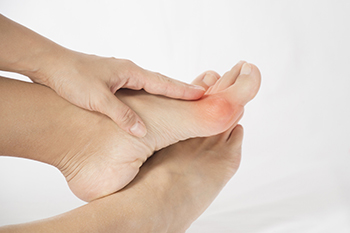Manalapan
(732) 845-0100
Manalapan (732) 845-0100

A hammertoe is when there is a deformity of the middle joint of a toe and the toe bends up or down abnormally, resembling a hammer. Hammertoe typically happens to the second, third, or fourth toes, but can also occur on the pinky toe. This condition happens from an imbalance in muscles, ligaments, and tendons in the middle joint of the toe. It can be caused by wearing shoes that do not have enough room in the toe box, foot type and structure, or injury to the foot. A hammertoe can become painful, making it difficult to walk, and it may be hard to find shoes to comfortably accommodate the abnormality. Depending on the severity of the hammertoe, stretching and strengthening exercises can help straighten the toe and minimize discomfort. Such exercises include towel toe curls, where one sits in a chair with their feet flat on a towel placed on the floor. One then can curl their toes and try to scrunch up the towel followed by extending the toes to push the scrunched towel forward. It is suggested that this be done 10 times and three times a day. Another exercise is sitting on the edge of a chair or a bed, placing the affected leg on the opposite knee, and bending the toes toward the body and then away from the body. Each position should be held for 30 to 40 seconds, and three to five sets should be done three times a day. If you are having a problem with hammertoe, it is suggested that you consult with a podiatrist who can provide additional exercises and assess the proper treatment for you.
Hammertoes can be a painful condition to live with. For more information, contact Dr. Charles Marchese of Manalapan Foot & Ankle. Our doctor will answer any of your foot- and ankle-related questions.
Hammertoe
Hammertoe is a foot deformity that occurs due to an imbalance in the muscles, tendons, or ligaments that normally hold the toe straight. It can be caused by the type of shoes you wear, your foot structure, trauma, and certain disease processes.
Symptoms
Risk Factors
Treatment
If you have hammertoe, you should change into a more comfortable shoe that provides enough room for your toes. Exercises such as picking up marbles may strengthen and stretch your toe muscles. Nevertheless, it is important to seek assistance from a podiatrist in order to determine the severity of your hammertoe and see which treatment option will work best for you.
If you have any questions, please feel free to contact our offices located in Manalapan, NJ, and Staten Island, NY . We offer the newest diagnostic and treatment technologies for all your foot care needs.

The foot is made up of a collection of tendons, ligaments, and muscles that connect its 26 bones and keep its many joints working. An injury to one of the tendons in the foot can cause pain and inflammation to that part of the foot that also may spread to other parts of it. Foot tendon injuries may be caused simply from wearing improperly fitting shoes, especially high heels. Other possible causes of a tendon injury include repetitive sports activity or some type of trauma to the foot. Sometimes, it’s just a matter of aging, as the tendons experience wear and tear over the years. Being overweight is thought to be a further cause of such injuries, due to the increased amount of pressure on the feet. Overstretched tendons can cause significantly painful injury from degenerative tears in the tissue, and athletes whose sport involves sudden stops and starts are more at risk for tendon injury. If you believe your foot pain may be the result of a tendon injury, it is suggested that you consult a podiatrist who can perform diagnostic tests to determine the cause and suggest treatment options for you.
Foot Pain
Foot pain can be extremely painful and debilitating. If you have a foot pain, consult with Dr. Charles Marchese from Manalapan Foot & Ankle. Our doctor will assess your condition and provide you with quality foot and ankle treatment.
Causes
Foot pain is a very broad condition that could be caused by one or more ailments. The most common include:
Diagnosis
To figure out the cause of foot pain, podiatrists utilize several different methods. This can range from simple visual inspections and sensation tests to X-rays and MRI scans. Prior medical history, family medical history, and any recent physical traumatic events will all be taken into consideration for a proper diagnosis.
Treatment
Treatment depends upon the cause of the foot pain. Whether it is resting, staying off the foot, or having surgery; podiatrists have a number of treatment options available for foot pain.
If you have any questions, please feel free to contact our offices located in Manalapan, NJ, and Staten Island, NY . We offer the newest diagnostic and treatment technologies for all your foot care needs.

Thickened and discolored toenails could be caused by toenail fungus, but other conditions can cause the same symptoms. These signs might also be the result of bruises, warts, or some type of skin cancer. With toenail fungus, beyond discoloration of the nail, there may be debris under the nail, nail thickening, and an irregularity to the white part of the nail. A discolored spot under the toenail may be a sign of melanoma, a possibly fatal form of skin cancer. This usually presents as a brown or black streak that might look like a bruise. Darier disease is a genetic disorder that typically causes yellowish, wartlike blemishes on the body and red and white streaks on toenails. If you notice changes to your toenails and you do not know the cause, it is suggested that you see a podiatrist as soon as possible to treat whatever might be causing the condition.
If left untreated, toenail fungus may spread to other toenails, skin, or even fingernails. If you suspect you have toenail fungus it is important to seek treatment right away. For more information about treatment, contact Dr. Charles Marchese of Manalapan Foot & Ankle. Our doctor can provide the care you need to keep you pain-free and on your feet.
Symptoms
Treatment
If self-care strategies and over-the-counter medications does not help your fungus, your podiatrist may give you a prescription drug instead. Even if you find relief from your toenail fungus symptoms, you may experience a repeat infection in the future.
Prevention
In order to prevent getting toenail fungus in the future, you should always make sure to wash your feet with soap and water. After washing, it is important to dry your feet thoroughly especially in between the toes. When trimming your toenails, be sure to trim straight across instead of in a rounded shape. It is crucial not to cover up discolored nails with nail polish because that will prevent your nail from being able to “breathe”.
In some cases, surgical procedure may be needed to remove the toenail fungus. Consult with your podiatrist about the best treatment options for your case of toenail fungus.
If you have any questions, please feel free to contact our offices located in Manalapan, NJ, and Staten Island, NY . We offer the newest diagnostic and treatment technologies for all your foot care needs.

Bunions are a common affliction of the foot in which the bones in the feet are misaligned, resulting in a bony bulge at the base of the big toe. The underlying causes of bunion might be genetic or related to some kind of injury to the big toe. It is common for some individuals with bunions to possibly mistake their bunion for another condition of the foot, such as sesamoiditis. However, the two conditions are importantly different. Although both bunions and sesamoiditis can affect the big toe, sesamoiditis is characterized by the inflammation of the two sesamoid bones that float below the big toe joint. This inflammation can occur as a result of overuse. Bunions, by contrast, are primarily characterized by the bony bulge at the sides of the big toes. If you are someone who believes that they may have bunions or a related condition, it is suggested that you contact a podiatrist to make an appointment.
If you are suffering from bunions, contact Dr. Charles Marchese of Manalapan Foot & Ankle. Our doctor can provide the care you need to keep you pain-free and on your feet.
What Is a Bunion?
A bunion is formed of swollen tissue or an enlargement of boney growth, usually located at the base joint of the toe that connects to the foot. The swelling occurs due to the bones in the big toe shifting inward, which impacts the other toes of the foot. This causes the area around the base of the big toe to become inflamed and painful.
Why Do Bunions Form?
Genetics – Susceptibility to bunions are often hereditary
Stress on the feet – Poorly fitted and uncomfortable footwear that places stress on feet, such as heels, can worsen existing bunions
How Are Bunions Diagnosed?
Doctors often perform two tests – blood tests and x-rays – when trying to diagnose bunions, especially in the early stages of development. Blood tests help determine if the foot pain is being caused by something else, such as arthritis, while x-rays provide a clear picture of your bone structure to your doctor.
How Are Bunions Treated?
If you have any questions, please feel free to contact our offices located in Manalapan, NJ, and Staten Island, NY . We offer the newest diagnostic and treatment technologies for all your foot care needs.